Tennis Equipment Statistics
Tennis is an equipment-heavy sport where even minor tweaks to the gear used can drastically change the way the game is played. In the tennis equipment industry, tech and innovation combine for players to achieve peak performance.
Top tennis equipment statistics
- The global tennis apparel market generated $526 million in 2022.
- It’s expected to grow at a CAGR of 8.30% to reach $919 million in 2029.
- Offline channels dominate the market, contributing $296 million in 2022 - its strength is attributable to customer assistance.
- In terms of CAGR, offline channels will still drive most of the growth, leading to the gap between offline and online channels widening further.
- North America leads the way by contributing 54.6% of tennis racket sales ($287 million) in 2022.
- Although Asia Pacific only generated $49 million in sales (9.3% MS), its growth is set to take off in the near future due to higher adoption in China, India, and Australia in recent years.
- Tweener rackets have the highest demand - equivalent to 41.2% of the market.
- Control rackets are a close second, generating 35.9% of tennis racket sales.
- Closed string rackets accounted for over 40% of tennis racket sales in 2022.
- Open-string rackets are positioned to grow well in the future because they’re easier to hit with and provide a greater amount of power and spin to swings.
- Carbon fibre tennis rackets have the highest demand because the material can accommodate a greater variety of tennis racket designs.
Tennis racket revenue by channel
- Offline channels’ tennis racket revenue reached $296 million in 2022 and is expected to reach $559 in 2029.
- Online channels provided $230 million in tennis racket revenue in 2022 and will deliver $360 in 2029.
- More of the growth in the tennis market will be attributable to offline channel sales because its CAGR of 9.50% exceeds the total market’s CAGR of 8.30%.
- Online channels’ CAGR lags behind with a respectable 6.62% year on year.
|
Revenue (in $ million) |
2022 |
2029 |
CAGR |
|
Offline |
$ 296 |
$ 559 |
9.50% |
|
Online |
$ 230 |
$ 360 |
6.62% |
|
Total |
$ 526 |
$ 919 |
8.30% |

- The offline channels dominated the market in 2022, contributing 56.3% of sales.
- Online channels’ participation in the market was also substantial, generating 43.7% of tennis racket revenues.
- This imbalance is set to get wider in 2029, with offline channels going up by 4.5% market share, while online channels will decline by the same amount.
|
Sales channel |
2022 market share |
2029 market share |
|
Offline |
56.3% |
60.8% |
|
Online |
43.7% |
39.2% |
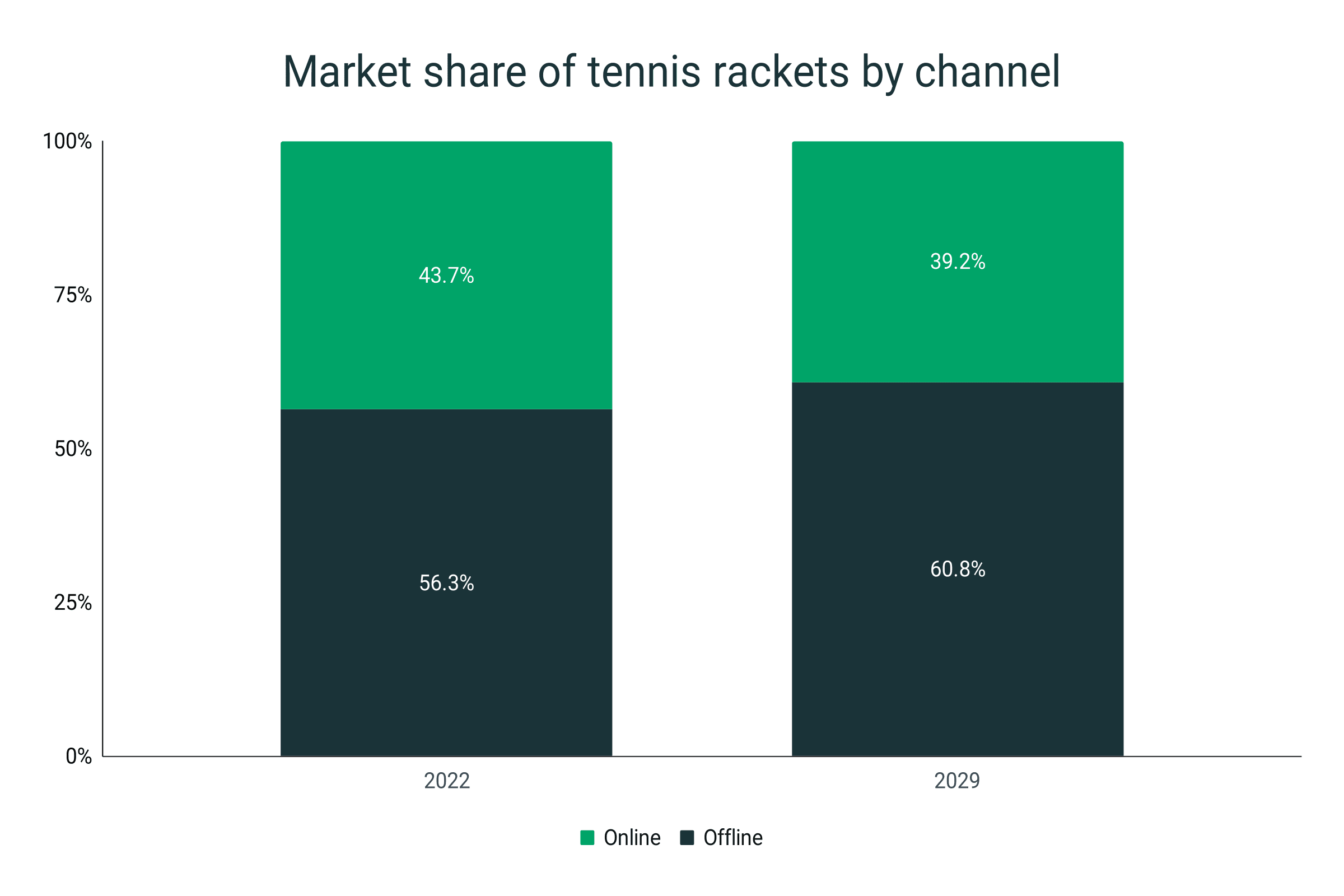
Tennis racket revenue by region
- The North American region adds a hefty $287 million in revenue to the tennis racket market.
- Europe follows, by contributing $112 million worth of tennis racket sales.
- The Asia Pacific market’s demand for tennis rackets reached $49 million in 2022.
- Middle East & Africa accounted for $42 million in tennis racket sales in 2022.
- $35 million worth of tennis rackets were sold in South America in 2022.
|
Region |
Revenue in 2022 ($ million) |
|
North America |
$ 287 |
|
Europe |
$ 112 |
|
Asia Pacific |
$ 49 |
|
Middle East & Africa |
$ 42 |
|
South America |
$ 35 |
|
Total |
$ 526 |
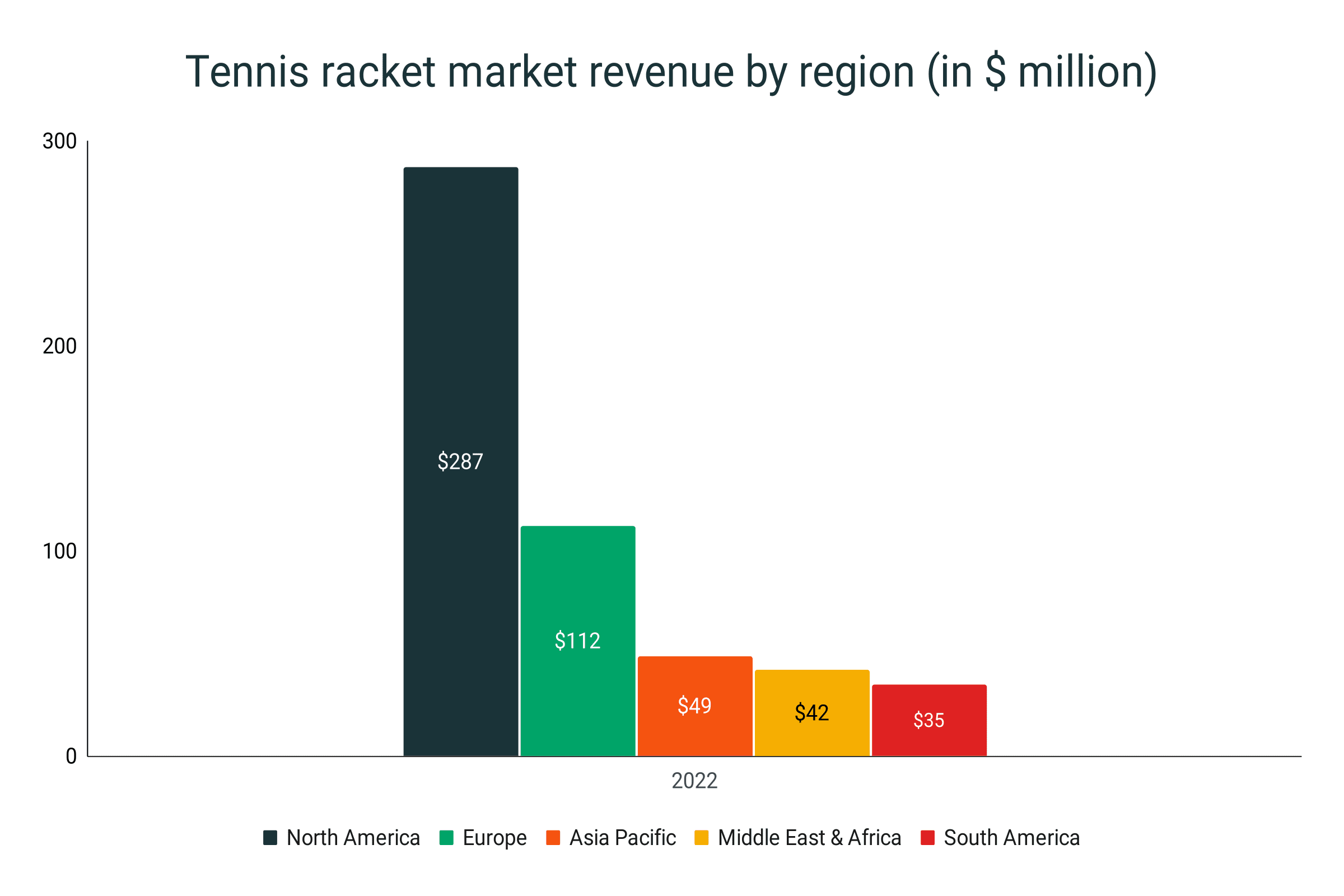
- North America dominates the market, accounting for more than half of tennis racket sales (54.6%) in 2022.
- Europe adds in a substantial 21.4% which is equivalent to about a fifth of the market.
- Asia Pacific sales contributed 9.3% of the total tennis racket market in 2022.
- Middle East and Africa generated 8.0% of the global tennis racket market’s revenue.
- South America contributed the least tennis racket sales vs other regions - equivalent to only 6.7% of the market.
|
Region |
2022 market share |
|
North America |
54.6% |
|
Europe |
21.4% |
|
Asia Pacific |
9.3% |
|
Middle East & Africa |
8.0% |
|
South America |
6.7% |
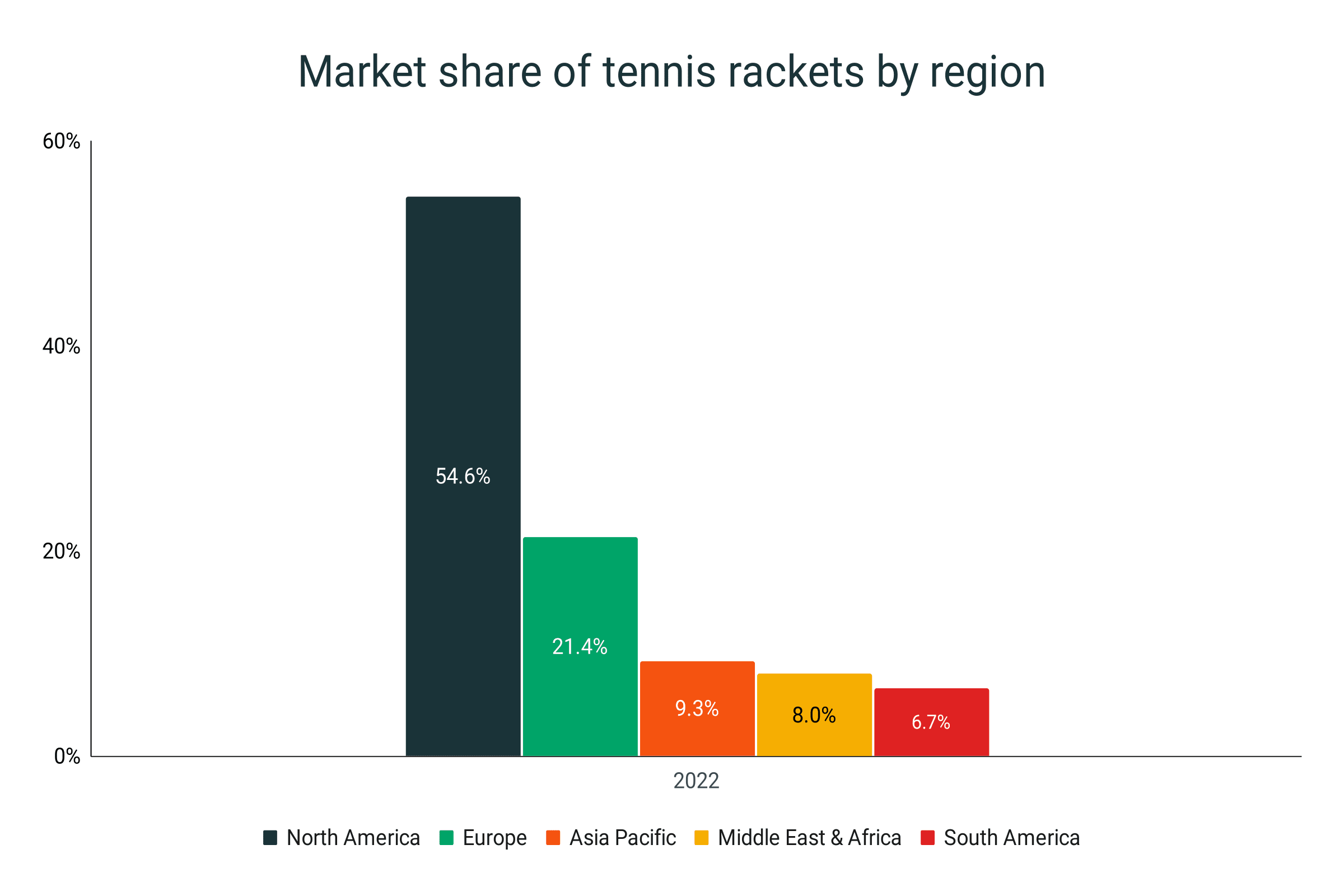
Tennis racket revenue by type
- Tweener rackets accounted for $217 million of global tennis racket sales.
- Control rackets contributed $189 million in tennis racket sales.
- Power rackets added another $121 million worth of tennis racket revenue.
|
Racket type |
2022 revenue ($ million) |
|
Tweener |
$ 217 |
|
Control |
$ 189 |
|
Power |
$ 121 |
|
Total |
$ 526 |
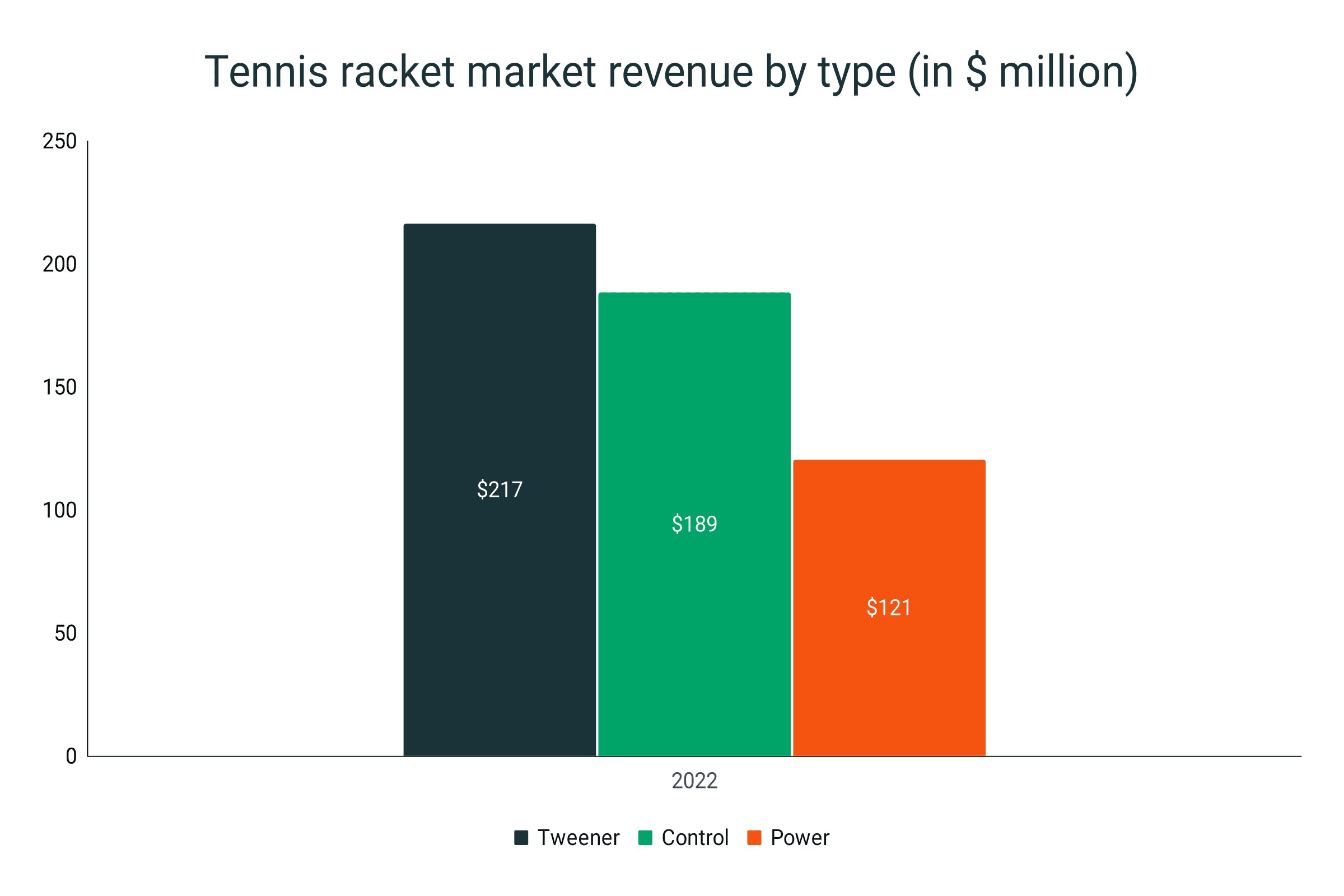
- In terms of shares, tweener rackets account for the most of any type - 41.2% of the market.
- Control rackets do not fall far behind, delivering 35.9% of racket sales in 2022.
- Power rackets contributed the least at 23.0% of the market, but this is still substantial - larger than a fifth of the market.
|
Tennis racket type |
2022 market share |
|
Tweener |
41.2% |
|
Control |
35.9% |
|
Power |
23.0% |
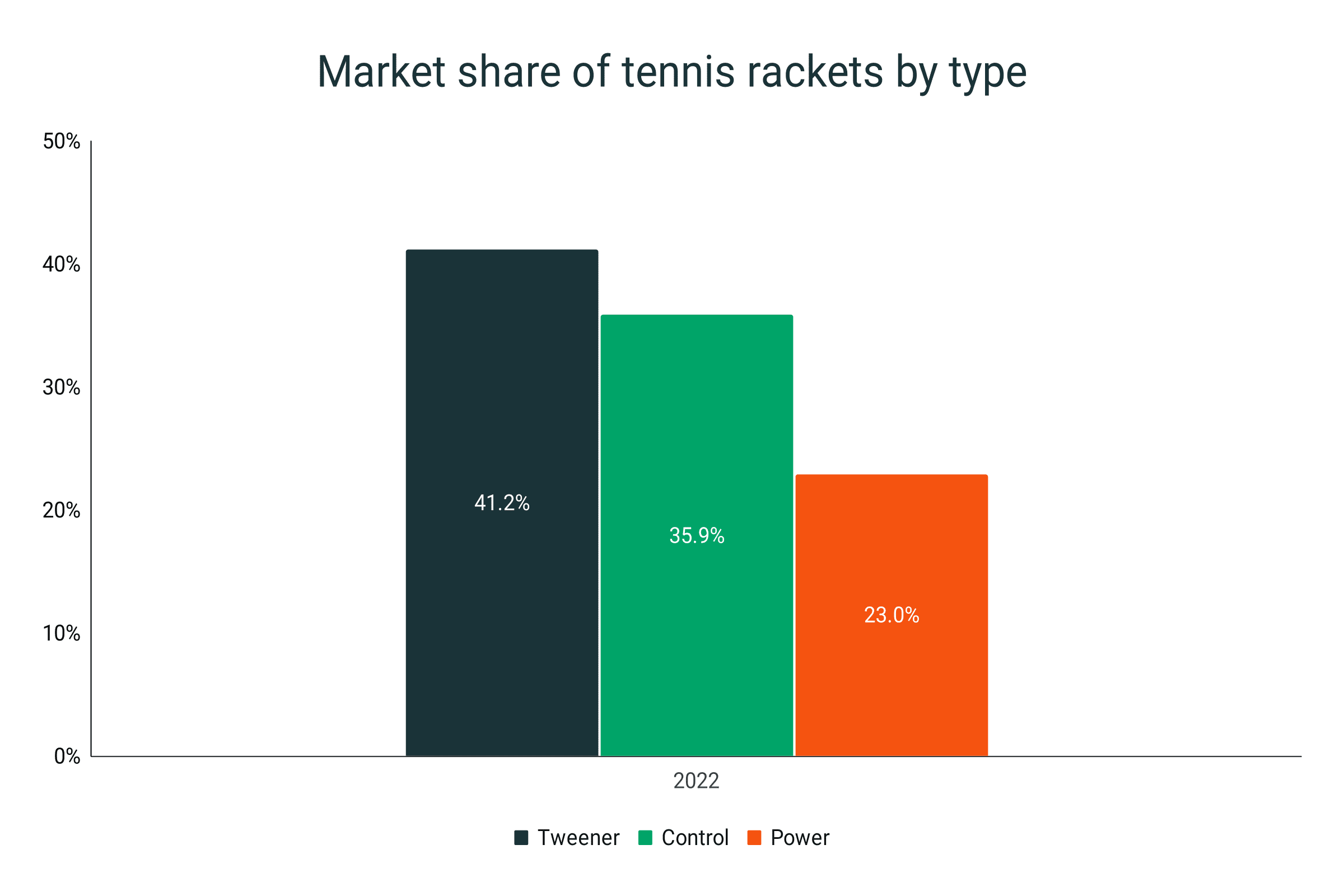
Tennis racket revenue by string type
- Closed string rackets generated a whopping $318 million of tennis racket sales in 2022.
- Open string rackets accounted for $208 million worth of tennis racket sales in 2022.
|
String type |
2022 revenue ($ million) |
|
Closed String |
$ 318 |
|
Open String |
$ 208 |
|
Total |
$ 526 |
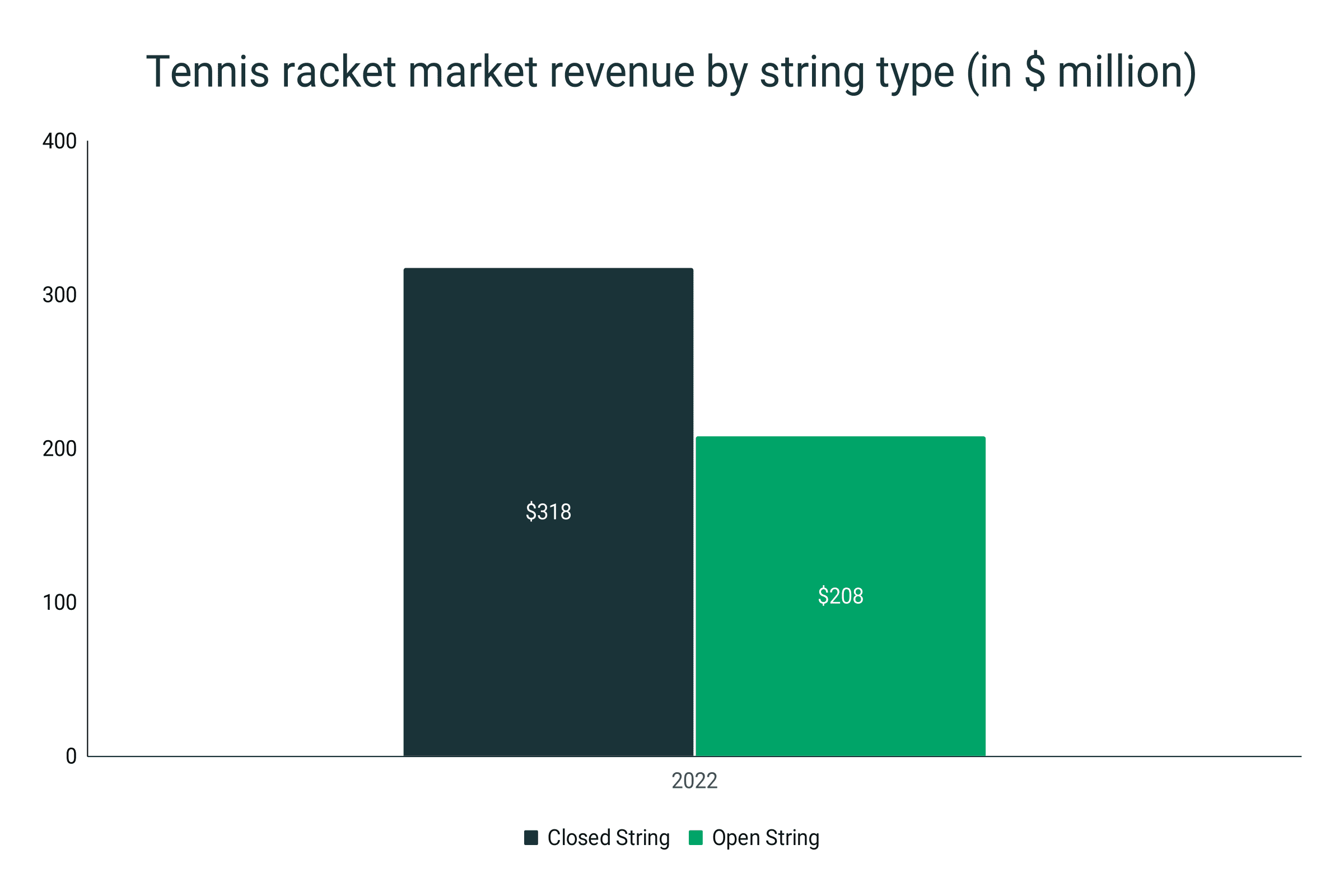
- Closed string rackets accounted for more than 60% of the global tennis racket market in 2022.
- Open string rackets generated 39.6% of 2022 tennis racket sales worldwide.
|
in % |
2022 |
|
Closed String |
60.4% |
|
Open String |
39.6% |
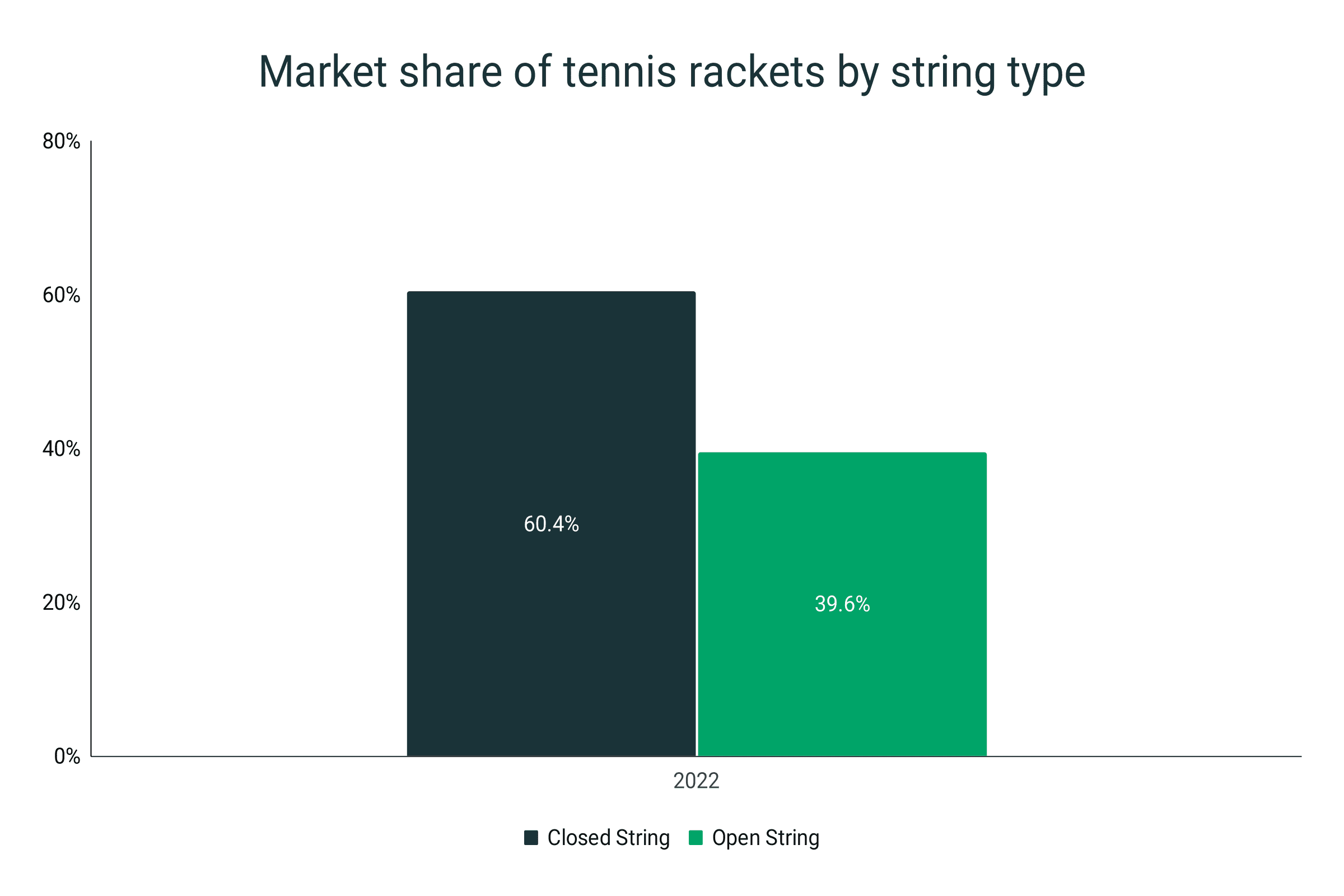
Tennis racket revenue by material
- Carbon fibre accounts for most of the purchased tennis rackets in 2018 - 80% of the total market.
- Aluminium is the next most used material, being used in 9.7% of tennis rackets sold in 2022 (based on dollar value).
- rackets made of other materials sold were worth 10.2% of the 2018 global tennis racket market.
|
Racket material |
2018 market share |
|
Carbon Fibre |
80.0% |
|
Aluminium |
9.7% |
|
Others |
10.2% |
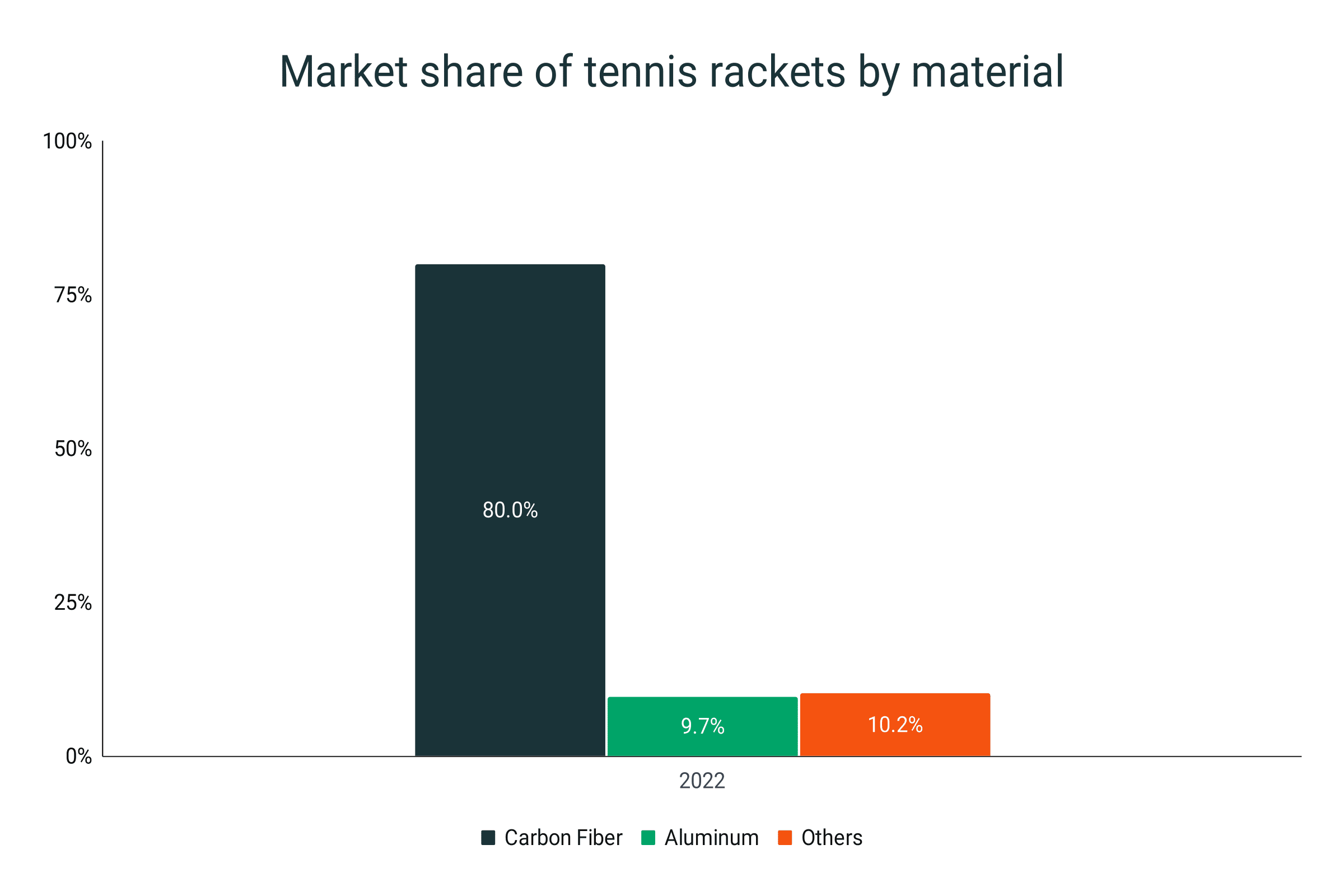
Top 75 ATP-ranked players and their racket sponsors
- HEAD and Wilson are head to head for the top spot, sponsoring 21 top 75 ATP-ranked players each.
- Yonex follows, being the official racket sponsor of 15 top 75 ATP-ranked players.
- Babolat is in 4th place, sponsoring 13.3% or 10 of the top 75 ATP-ranked players.
- Tecnifibre and Dunlop have a limited number of sponsored players, sponsoring 6 and 2 players, respectively.
- When it comes to the top 10 ATP-ranked players, HEAD dominates its competition by sponsoring 40% of them.
- Babolat and Yonex each sponsor 2 of the top 10 ATP-ranked players.
- Tecnifibre and Wilson both sponsor 1 of the top 10 ATP-ranked players.
|
Racket Brand |
# of Players Sponsored |
|
HEAD |
21 |
|
Wilson |
21 |
|
Yonex |
15 |
|
Babolat |
10 |
|
Tecnifibre |
6 |
|
Dunlop |
2 |
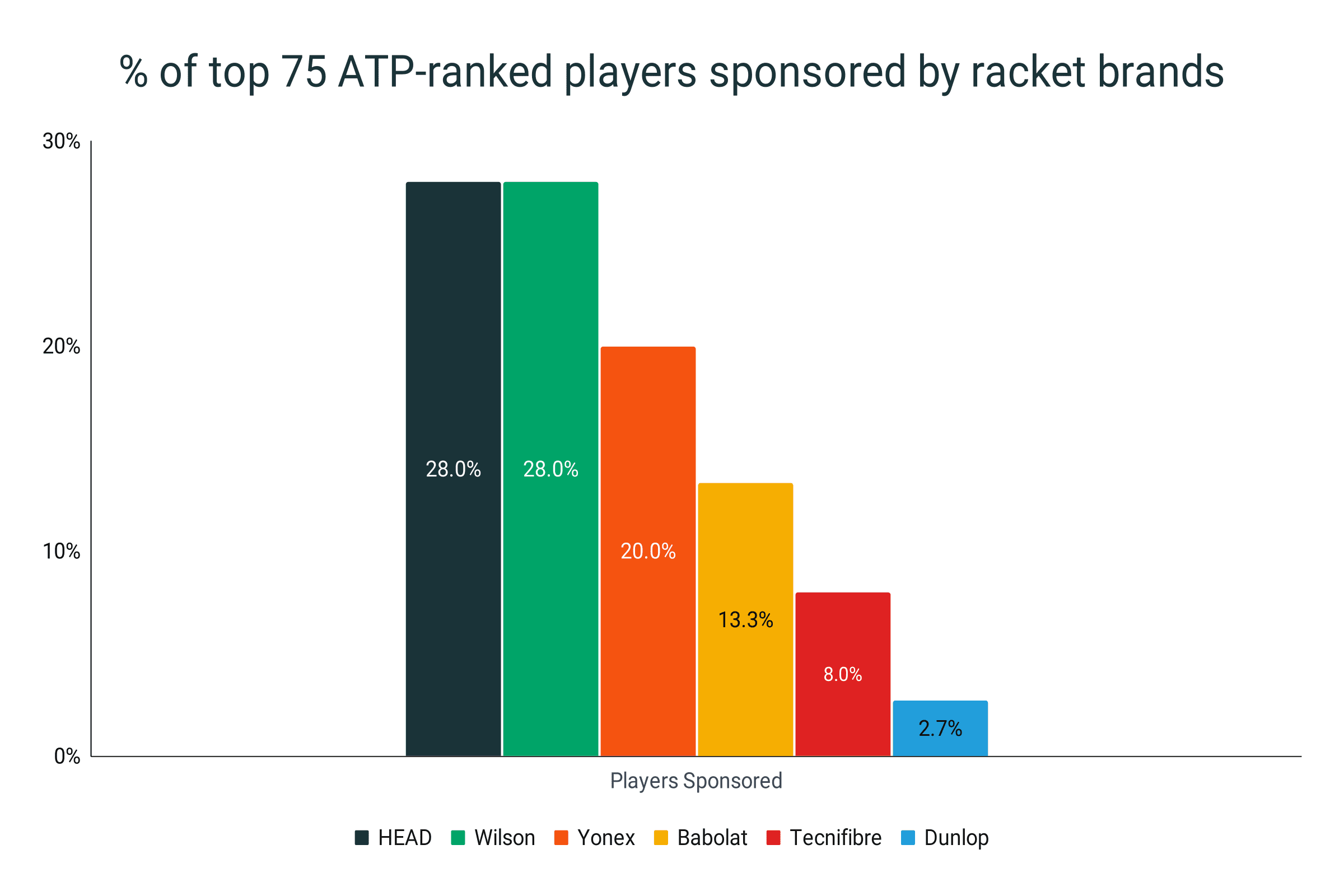
Top 75 WTA-ranked players and their racket sponsors
- Wilson sponsors the most top 75 WTA-ranked players with 31 players - equivalent to 41.3%.
- Yonex follows with 19 sponsored players which is a little bit higher than a fourth of the top 75 WTA-ranked players.
- Babolat and HEAD follow with 11 and 10 sponsored players, respectively.
- Tecnifibre and Artengo sponsor 3 and 1, respectively of the top 75 WTA-ranked players.
|
Racket Brand |
# of Players Sponsored |
|
Wilson |
31 |
|
Yonex |
19 |
|
Babolat |
11 |
|
HEAD |
10 |
|
Tecnifibre |
3 |
|
Artengo |
1 |

Tennis string revenue
- The global tennis string market was worth $61 million in 2022.
- It’s growing with a CAGR of 3.7% and will reach $79 million in 2029.
|
Year |
2022 tennis string market revenue ($ million) |
|
2022 |
$ 61 |
|
2023 |
$ 63 |
|
2024 |
$ 66 |
|
2025 |
$ 68 |
|
2026 |
$ 71 |
|
2027 |
$ 73 |
|
2028 |
$ 76 |
|
2029 |
$ 79 |
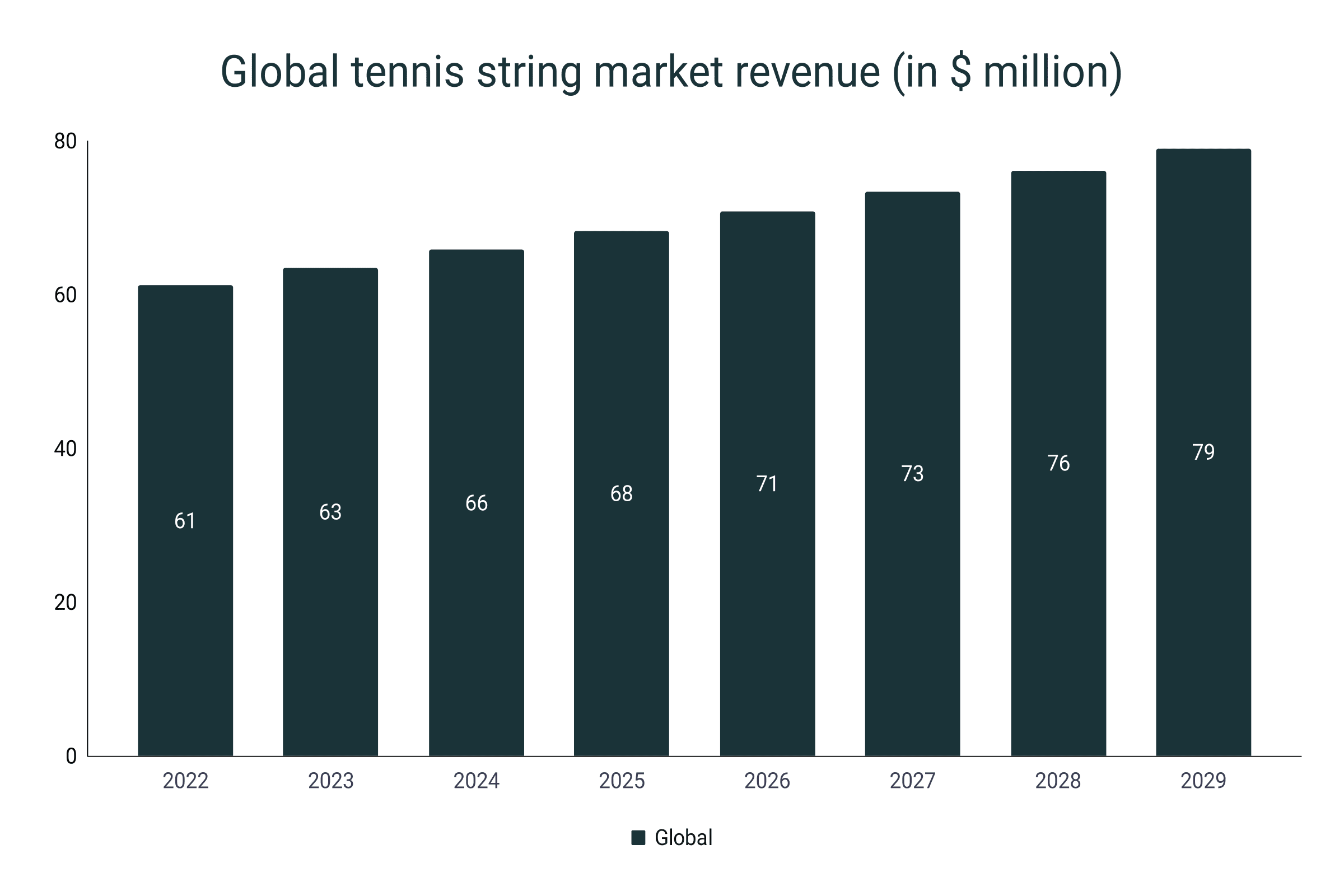
Tennis equipment facts
- Tennis rackets generally cost between $15 and $300.
- A good quality racket costs between $150 and $250.
- The Proximus Diamond Game Prize is the most expensive tennis racket in the world, with a market value of about $1.3 million.
- Tennis rackets generally range from 27 in and 27.5 in for adults, and 21 in to 27 in for kids.
- The average tennis racket weighs 10.6 oz.
- 10 oz is considered light, while 11 oz is considered heavy.
- The average tennis racket’s head size is between 96 and 100 sq in.
- rackets can be balanced to be heavier in either the racket’s head or handle.
- Head-heavy rackets offer more power, while head-light rackets provide more control.
- Tennis racket beams (frames) have varying widths. The average beam has a width between 22 and 24 mm.
- Any wider adds power but loses manoeuvrability, any thinner does the opposite.
- Babolat created the first tennis strings made out of sheep guts. The material is still used for some tennis strings.
- A microfilament string is made from 4 up to 250 microfilaments wound together.
- A new tennis racket should last at least 2 years but can reach up to a decade of use.
- Tennis racket tensions range from 50 to 60 lbs.
- Heavier tensions add more control, but lighter ones add power.
- The most commonly available tennis string gauge is between 1.20 mm and 1.30 mm.
- Thicker strings provide more durability and control while thinner strings add more power and spin.
- A rule of thumb of when to change tennis strings is to equate the number of times you restring a racket in a year with the number of times played in a week (e.g. playing twice a week signals a need to restring every 6 months).
Sources
https://www.maximizemarketresearch.com/market-report/global-tennis-racquet-market/54872/
https://www.factmr.com/report/238/tennis-racquet-market
https://www.grandviewresearch.com/industry-analysis/tennis-racquet-market
https://www.scoreandchange.com/tennis-sponsorships/
https://www.espn.com/tennis/rankings
https://tennishead.net/tennis-racket-specifications-explained/
https://www.tennis-warehouse.com/learning_center/gear_guides/tennis_string/material_gauge_tension_explained.html
https://www.forbes.com/sites/timnewcomb/2022/12/05/understanding-tennis-string-construction-and-why-it-matters/?sh=569ffdbf214a
https://market.us/report/tennis-string-market/
https://mytennishq.com/how-much-does-a-tennis-racket-cost/
https://penaltyfile.com/most-expensive-tennis-rackets/
https://www.wilson.com/en-us/blog/tennis/how-tos/how-often-should-i-re-string-my-tennis-racket
https://kids.kiddle.co/Racquet
https://www.tennis-warehouse.com/learning_center/gear_guides/tennis_string/babolat_natural_gut_the_original_tennis_string.html
